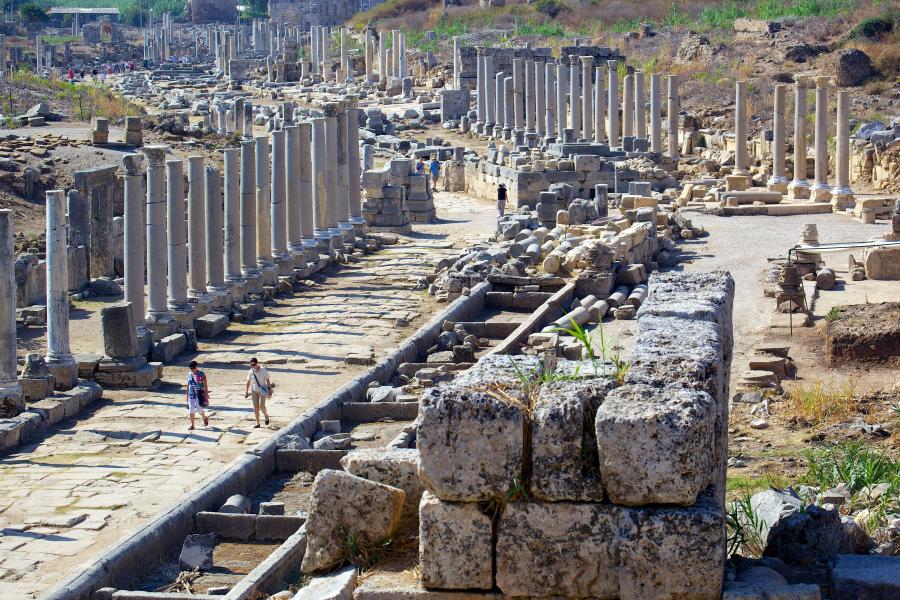
Perge
It is 17 km from Antalya city center. East of Perugia, Perge is one of the most regular Roman cities of Anatolia, not just of the region. It is famous for its marble sculpture beside its architecture. Since 1946, important monumental structures of the excavated city center have been excavated in Istanbul University. Thanks to the finds of the statues, Antalya Museum has become one of the richest Roman sculptures of the world.
The history of the establishment of Perge is shown after the historians Troia wars (1275 BC). The name of Perge in a Hittite tablet found in 1986 shows that this place was founded before the Troia war. Philological information of the city of BC. Some of the ceramics, stone tools and burials found have been down until the early Bronze Age. The first settlement in the city occurred on the hill in the north. Over time the city flourished on the plain in the south of the hill. Perge, which starts on Bergama and ends on Side and ends on the ancient road, owes its geographical importance and development especially to Aksu (Kestros) river. The river, which is not suitable for transportation today, plays a very important role not only in making the land efficient in the ancient times but also in terms of transportation in the city. It is known that Apostle Paulos and his friends sailed from Paphos port in Cyprus and reached Perge. There is no doubt that this can only be through Kestros. This integration of the city with the river is also understood from the statue of the river god (kestros) in the monumental nymphaeum on the southern side of the acropolis, ridges and ridges.
Among the tarihe past personalities of the city, the famous “Pergeli Apollonius” takes the front row in astronomy, geometry and mathematics. Other famous Pergeli İ.S. Varus is the philosopher who lived in the 2nd century BC. Despite the fact that many gods and goddesses have worshiped in Perge, Artemis has a special place and preciousness in them. It was the chief goddess of the city of Artemis, whose roots were based on ancient times, and which predominantly referred to as VVanessa-Preiia (the queen of Perge) on the indigenous side. The cult of the goddess, known as Artemis Pergaia in the city, spread to neighboring cities and even to overseas countries. The Temple of Artemis, which is wonderful in terms of size, beauty and construction, which many ancient writers have spoken, was located on a hill high above the city, the place still remains to this day. Excavations and explorations show that Perge generally goes through three bright periods. First semester BC 3rd and 2nd y.y. It belongs to the Hellenistic period, and this period is partly represented by magnificent walls and towers. The second period is encountered by the Roman Empire devrine (2 nd to 3 rd year old), which is now hammering monumental constructions (theater, stadium, baths, monumental fountains and agora), many of which are still standing today. The last period of prosperity is the Christian era; 5. and 6.y.y. The city became a metropolitan center within the city church organization and many churches were built.
BC In 333, Alexander the Great’s visit to the Iskenderids, with no resistance to the Pergilites during the settlement of the region, is linked to the lack of walls protecting the city.
Today, two round-shaped towers and fortification walls, which are the most monumental structures of the city and became a symbol of the city, were built after the capture of Alexander. The remains that can be visited today are mostly Roman. One of the main lines of the city plan of Perge is the two main streets in the north-south direction and the other east-west direction. The colonnaded street which is the backbone of the city starts from the Hellenistic gate and ends in the monumental nymphaeum (fountain) on the edge of the acropolis. In the center of the approximately 300 meter long street, there is a two meter wide partitioned water channel, with mosaic porticoes and shops on both sides. The channel nourished from the nymphaeum in the north had to be a source of life for the cadden and the shops on hot summer days. At the city center where the streets intersect, there is Apollonius Demetrius jewelry. The first building on the road leading to the city in today’s settlement is the monumental theater building built in Greek-Roman style. Approximately 12 thousand person capacity İ.S. The building dated to the 2nd century BC is famous for its rich marble decoration of the stage building. Prof. Dr. The sculptures of the theater sculpted by Jale İNAN and his team from 1985-1993 are exhibited in the Antalya Museum’s “Perge Theater Hall”. One of the best preserved stadiums of Anatolia is located in the north of the theater. Agora, another planned center of the city with different planned centers, baths and other structures that can be seen palaestra. Both architectural and sculptural artifacts excellence emphasize that Perge is the city of sculpture with its own distinctive lines.













